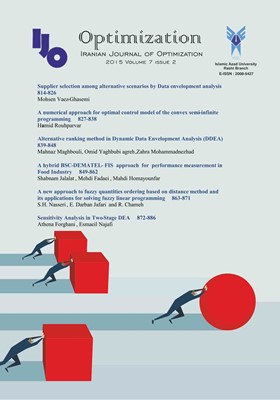A numerical approach for optimal control model of the convex semi-infinite programming
محورهای موضوعی : Non linear Programming
1 - Department of Mathematics, Saveh Branch, Islamic Azad University, Saveh, Iran.
کلید واژه: Neural Networks, Optimal Control, Iterative dynamic programming, Convex semi-infinite programming,
چکیده مقاله :
In this paper, convex semi-infinite programmingis converted to an optimal control model of neural networks and the optimal control model issolved by iterative dynamicprogramming method. In final, numerical examples are provided forillustration of the purposed method.
In this paper, convex semi-infinite programmingis converted to an optimal control model of neural networks and the optimal control model issolved by iterative dynamicprogramming method. In final, numerical examples are provided forillustration of the purposed method.
[1] Ben Tal A. and Kerzner L. and Zlobec S., Optimality conditions for convex semi-infinite programming problems, Naval Research Logistics, Vol. 27, N. 3, pp. 413-435, (1980).
[2] Hettich R. and Kortanek K.O., Semi-infinite programming: theory, methods and applications, SIAM Review, Vol. 35, pp.380-429, (1993).
[3] Hettich R. and Still G., Second order optimality conditions for generalized semi-infinite programming problems, Optimization, Vol. 34, pp. 195-211, (1995).
[4] Kennedy M.P. and Chua L.O., Unifying the Tank and Hopfield linear programming circuit and the Canonical nonlinear programming circuit of Chua and Lin"}, IEEE Trans. Circuits Systems, CAS-34, pp. 210-214, (1987).
[5] Kortanek K.O. and Medvedev V.G., Semi-infinite programming and new applications in Finance, Encyclopedia of Optimization, C Floudas and Panos Pardalos (Eds.), Kluwer Academic, accepted (2005).
[6] Kostyukova O.I. and Tchemisova T.V., Convex semi-infinite programming: explicit optimality conditions, Tech. Rep., Preprint, (2005).
[7] Kostyukova O.I. and Tchemisova T.V. and Yermalinskaya S.A., Convex semi-infinite programming: implicit optimality criterion based on the concept of immobile points, (to appears).
[8] Lin J.S and Hwang C., Enhancement of the global convergence of using iterative dynamic programming to solve optimal control problems"}, Ind. Eng. Chem. Res., Vol. 37, pp. 2469-2478, (1998).
[9] Luenberger D.G., Linear and nonlinear programming, 2nd edn., Addison-Wesley, Reading, MA, (1984).
[10] Luhandjula M.K. and Ouanes M., A cutting-plane approach for semi-infinite mathematical programming, African Journal of Science and Technology (AJST), Science and Engineering Series, Vol. 2, No 1, pp. 1-10, (2001).
[11] Luus R., Iterative dynamic programming, London, UK: Chapman and Hall/CRC, (2000).
[12] Luus R., Effect of the choice of final time in optimal control of nonlinear systems, Can. J. Chem. Eng. Vol. 69, pp. 144-151, (1991).
[13] Luus R., Numerical convergence properties of iterative dynamic programming when applied to high dimensional systems, Chem. Eng. Res. Des. Vol. 74, pp. 55-62, (1996).
[14] Luus, R., Optimal control by dynamic programming using accessible grid points and region reduction, Hung. J. Ind. Chem. Vol. 17, pp. 523-543, (1989).
[15] Luus, R., Optimal control by dynamic programming using systematic reduction in grid size, Int. J. Control Vol. 19, pp. 995-1013, (1990).
[16] Maa C.-Y. and Shanblatt M.A., Linear and quadratic programming neural network analysis, IEEE Trans. Neural Networks, Vol. 3, pp. 580-594, (1992).
[17] Polak E., Semi-infinite optimization in engereeng desigh, in semi-infinite programming and applications, int. Symp., Austin/Tex.1981, Lect. Notes Econ. Math. Syst., N 215, pp. 236-248, (1983).
[18] Song Q. and Leland R.P., An optimal control model of neural networks for constrained optimization problems, Optim. Control Appl. Meth., Vol. 19, pp. 371-376, (1998).
[19] Weber G.-W., Generalized semi-infinite optimization: theory and applications in optimal control and discrete optimization, in special issue' Optimality conditions, general convexity and duality in vector optimization', A.Cambini, L.Martein (eds), J. Statistic and Management Systems, N. 5, p.359-388, (2002).


